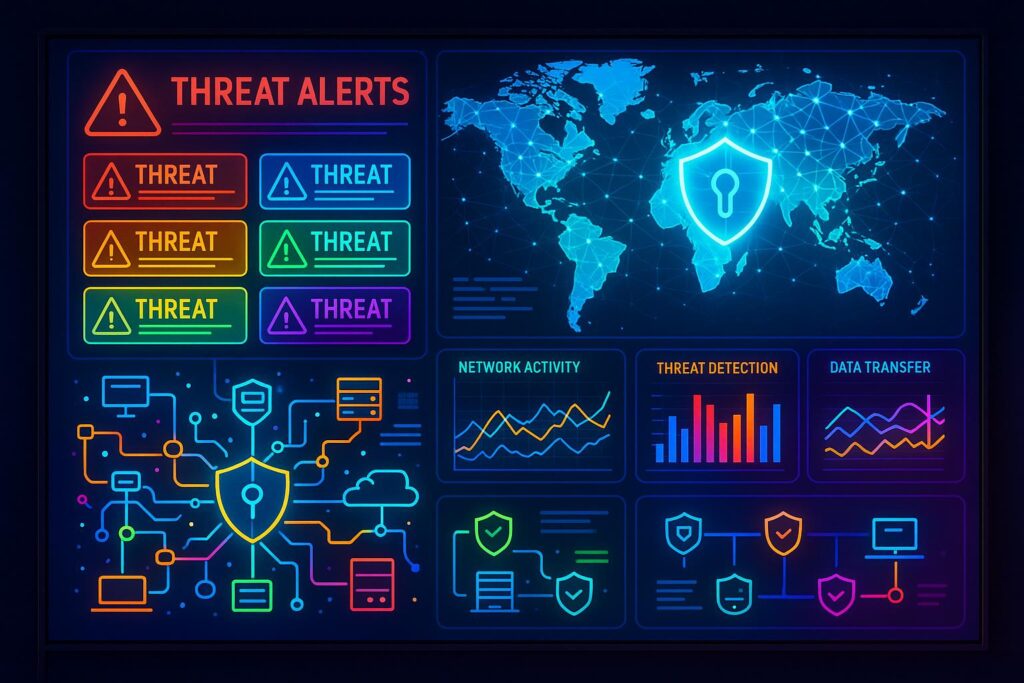Listen to the article
As organisations seek robust cybersecurity solutions, the search for effective Managed Detection and Response (MDR) providers grows increasingly competitive, with Alert Logic facing an array of alternatives in 2026. This landscape features 11 key competitors, each offering distinctive approaches to detection, threat hunting, incident response, and integration capabilities, tailored to fit diverse IT stacks and security needs.
CrowdStrike Falcon Complete stands out as a premium MDR service delivered natively on the Falcon platform. It integrates endpoint, identity, cloud workload, and next-generation SIEM data within a unified system, enabling swift, coordinated threat containment without the complexity of stitching together multiple tools. CrowdStrike’s offering is enhanced by its 24/7 adversary threat hunting team, OverWatch, providing wide-ranging visibility and rapid incident response. However, potential customers should note that pricing can vary significantly depending on the selected modules and scope, with estimates ranging from approximately $70,000 to over $400,000 annually. Despite its premium cost, buyers often find value in its instant incident response capabilities, as reflected in its high user ratings.
Arctic Wolf’s MDR service, branded as Concierge SOC, emphasises a continuous improvement model through its named Concierge Security Teams. These teams provide round-the-clock monitoring across endpoints, identity, cloud, and network environments, coupled with documented runbooks and regular business reviews aimed at transforming alerts into actionable security posture changes. The acquisition of Cylance technology has bolstered Arctic Wolf’s capabilities with advanced endpoint protection integrated into its Aurora platform. Pricing for Arctic Wolf typically falls between $30,000 and $320,000 per year, reflecting its customized, quote-based approach. Its unique flat-fee packaging appeals to organisations preferring predictable budgeting, although it is often recommended to use alongside an existing Endpoint Detection and Response (EDR) system.
UnderDefense offers a tool-agnostic MDR framework, which operates on the customer’s existing EDR, identity providers, SaaS, cloud, and network tools. This flexible model focuses on measurable outcomes, such as reducing mean time to respond (MTTR) and enhancing threat hunting precision using ATT&CK-framework detection engineering. UnderDefense also provides extensive support in compliance and digital forensics, and integrates SOAR and ITSM playbooks for seamless incident workflows. With industry-leading response benchmarks, approximately 2 minutes from alert to triage and about 15 minutes to containment, the service boasts stellar customer satisfaction. Pricing ranges between $60,000 and $240,000 annually, with a focus on tailoring to specific customer environments without requiring a disruptive rip-and-replace strategy.
Expel’s MDR offering utilises its Workbench platform to deliver 24/7 monitoring across endpoints, cloud, identity, network, and email, emphasising integration with existing tools for effortless deployment and rapid time-to-value. The platform is noted for clear incident narratives and focused remediation guidance. Pricing varies widely, generally between $80,000 and $350,000 per year, reflecting data volume and scope considerations. Expel is lauded for its well-rounded cloud and SaaS coverage, appealing to organisations seeking outcome-driven services that complement their current security investments.
Sophos MDR integrates closely with the Sophos Central stack, combining endpoint, server, firewall, and email signals into a single console with tiered service offerings. This consolidation appeals to buyers favouring fast onboarding and clear, actionable analyst communication, though it performs optimally when paired with other Sophos tools. Pricing generally ranges from $40,000 to over $300,000 per year. While it attracts praise for usability, some customers have reported concerns around rising renewal costs and changing service scopes.
eSentire combines its Atlas XDR platform with a fully staffed security operations centre (SOC), providing comprehensive coverage across endpoints, network, identity, SaaS, and cloud environments. Its focus on swift triage and skilled analyst interventions make it a strong candidate for organisations aiming to consolidate security alerts without replatforming. Common cautions include occasional communication challenges and a less user-friendly portal experience, aspects organisations should test during proof-of-concept engagements. Pricing generally situates in the $70,000 to $350,000+ range.
Cisco’s XDR and optional MDR services leverage its Talos threat intelligence, integrating telemetry from Secure Endpoint, Duo MFA, Umbrella DNS protection, firewalls, and cloud solutions. Ideal for enterprises already embedded in Cisco’s ecosystem, this offering provides broad telemetry correlation and frontline incident response capabilities. Notwithstanding, user feedback highlights complexity in licensing and mixed reviews on certain firewall products, advising careful evaluation of total cost of ownership. Pricing typically ranges from $70,000 to $300,000 annually.
Check Point’s Infinity platform delivers managed detection (MDR) and prevention (MPR), operating with 24/7 SOC oversight across endpoint, network, email, cloud, and IoT. Its XDR technologies correlate multi-product events for unified views and automated cross-tool responses. Organisations using Check Point firewalls and endpoint solutions may find cost-effective consolidation, but they should scrutinize manageability of policies and support responsiveness during trials. Pricing is typically between $50,000 and $250,000 annually.
Red Canary offers an EDR-agnostic MDR service that enhances the telemetry from widely used EDR vendors with expert 24/7 analysis, detection engineering, and guided response. Its swift onboarding and comprehensive narrative reporting stand out, although users are advised to confirm coverage scope, especially regarding non-EDR data sources and retention limits. Pricing falls within $50,000 to $280,000 per year, with added caution to monitor potential product packaging shifts after Red Canary’s acquisition by Zscaler.
Secureworks’ Taegis MDR, supported by its Counter Threat Unit, blends 24/7 analyst monitoring with XDR capabilities across endpoints, cloud, identity, and network layers. It is praised for solid detection content and clear incident summaries, although complexity in delineating roles among XDR, MDR, and IT Detection and Response (ITDR) requires explicit upfront clarification for smooth implementation. Pricing typically ranges from $60,000 to $320,000.
Rapid7’s Managed Threat Complete integrates its Insight platform’s SIEM and vulnerability management with MDR services, providing comprehensive monitoring and response across IT environments. This linkage is especially valuable for organisations seeking to unite vulnerability, cloud posture, and threat response. Customers are encouraged to verify the contract’s scope and action authority, as some have reported inconsistencies in alert forwarding and operational fit. Pricing is more accessible, usually around $30,000 to $150,000 yearly.
For buyers transitioning from Alert Logic or exploring MDR, a robust checklist is essential to cut through vendor marketing and ensure solutions meet practical needs. Key elements include verifying wide scope and coverage across endpoints, identity, SaaS, cloud, network, and email, confirming rapid minutes-to-containment service level objectives, ensuring pre-authorized actions with rollback capabilities, and validating clean integration with existing security tools. Additionally, monitoring vendor support availability, surge incident response readiness, reliable data export at contract termination, and clear pricing models with no surprise overages are vital. Running proof-of-concepts with identical scenarios across two or three finalists helps elucidate real-world performance and integration fit.
UnderDefense’s pitch epitomises a new generation of MDR by focusing on fast, measurable containment without requiring customers to abandon their existing security technologies. Its tool-agnostic model, combined with continuous threat hunting and well-documented remedial playbooks, promises to accelerate or even replace SOC operations with transparent ownership and high customer satisfaction. Real-world examples demonstrate their capacity to detect subtle, low-signal breaches and respond decisively with durable policy enhancements.
As cybersecurity environments evolve, organisations aiming to replace or supplement Alert Logic with MDR services benefit from carefully matched solutions that align operational needs, technology stacks, cost constraints, and service expectations. The top contenders in 2026 emphasise a mix of platform-native and flexible integrations, expert-led monitoring, and rapid response, underscored by transparent pricing and thorough buyer guidance to ensure security complexity is managed with clarity and confidence.
📌 Reference Map:
- [1] (UnderDefense) – Entire article
- [2] (CrowdStrike) – Paragraphs 2, 4, 6
- [3] (Arctic Wolf) – Paragraphs 3, 5
- [4] (CrowdStrike) – Paragraph 2
- [5] (Arctic Wolf) – Paragraph 5
- [6] (CrowdStrike) – Paragraph 2
- [7] (Arctic Wolf) – Paragraph 5
Source: Noah Wire Services


